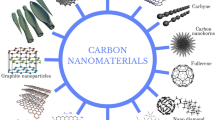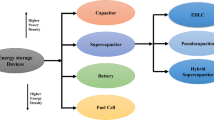Abstract
Carbon nanotube (CNT)-based transparent conducting films (TCFs) have been prepared by filtration of (i) surfactant-based aqueous dispersions and (ii) organic solutions obtained by reductive dissolution of an alkali metal salt of polyelectrolyte nanotubes. Starting from the same source of nanotubes, it is shown that films obtained by the reductive dissolution route present up to one order of magnitude better conductivity for the same transmittance. Light scattering experiments show that the average CNT length is much larger for the reductive dissolution-based organic solutions than for the sonication aided aqueous dispersions. Values of surface resistivity of 200 ohm per square have been obtained for 80% transmittance. Additionally, it is shown that the CNT-based TCFs are undistinguishable from indium tin oxide (ITO) as electrodes in regular environments, whereas they perform efficiently in acidic environments where ITO fails.







Similar content being viewed by others
References
C.M. Aguirre, S. Auvray, S. Pigeon, R. Izquierdo, P. Desjardins, and R. Martel: Carbon nanotube sheets as electrodes in organic light-emitting diodes. Appl. Phys. Lett. 88, 183104 (2006).
E. Artukovic, M. Kaempgen, D.S. Hecht, S. Roth, and G. Grüner: Transparent and flexible carbon nanotube transistors. Nano Lett. 5, 757–760 (2005).
Z. Wu, Z. Chen, X. Du, J.M. Logan, J. Sippel, M. Nikolou, K. Kamaras, J.R. Reynolds, D.B. Tanner, A.F. Hebard, and A. Rinzler: Transparent, conductive carbon nanotube films. Science 305, 1273–1276 (2004).
R. Andrews, D. Jacques, M. Minot, and T. Rantell: Fabrication of carbon multiwall nanotube/polymer composites by shear mixing. Macromol. Mater. Eng. 287, 395–403 (2002).
B. Vigolo, A. Penicaud, C. Coulon, C. Sauder, R. Pailler, C. Journet, P. Bernier, and P. Poulin: Macroscopic fibers and ribbons of oriented carbon nanotubes. Science 290, 1331–1334 (2000).
L. Viry, C. Mercader, P. Miaudet, C. Zakri, A. Derré, A. Kuhn, M. Maugey, and P. Poulin: Nanotube fibers for electromechanical and shape memory actuators. J. Mater. Chem. 220, 3487–3495 (2010).
T. Fukushima, K. Asaka, A. Kosaka, and T. Aida: Fully plastic actuator through layer-by-layer casting with ionic-liquid-based bucky gel. Angew. Chem. Int. Ed. Engl. 44, 2410–2413 (2005).
C. Bartholome, A. Derré, O. Roubeau, C. Zakri, and P. Poulin: Electromechanical properties of nanotube–PVA composite actuator bimorphs. Nanotechnology 19, 325501 (2008).
G.B. Blanchet, C.R. Fincher, and F. Gao: Polyaniline nanotube composites: A high-resolution printable conductor. Appl. Phys. Lett. 82, 1290–1292 (2003).
K. Saint-Aubin, P. Poulin, H. Saadaoui, M. Maugey, and C. Zakri: Dispersion and film-forming properties of poly(acrylic acid)-stabilized carbon nanotubes. Langmuir 25, 13206–13211 (2009).
K. Shen, S. Curran, H. Xu, S. Rogelj, Y. Jiang, J. Dewald, and T. Pietrass: Single-walled carbon nanotube purification, pelletization, and surfactant-assisted dispersion: A combined TEM and resonant micro-raman spectroscopy study. J. Phys. Chem. B 10, 4455–4463 (2005).
K.L. Lu, R.M. Lagon, Y.K. Chen, M.L.H. Green, and P.J.F. Harris: Mechanical damage of carbon nanotubes by ultrasound. Carbon 34, 814–816 (1996).
A. Lucas, C. Zakri, M. Maugey, M. Pasquali, P. vd Schoot, and P. Poulin: Kinetics of nanotube and microfiber scission under sonication. J. Phys. Chem. C 113, 20599–20605 (2009).
G. Pagani, M.J. Green, P. Poulin, and M. Pasquali: Competing mechanisms and scaling laws for carbon nanotube scission by ultrasonication. Proc. Natl. Acad. Sci. U. S. A. 109, 11599–11604 (2012).
A. Pénicaud, P. Poulin, A. Derré, E. Anglaret, and P. Petit: Spontaneous dissolution of a single-wall carbon nanotube salt. J. Am. Chem. Soc. 127, 8–9 (2005).
S. Fogden, C. Howard, R.K. Heenan, N.T. Skipper, and M.S.P. Shaffer: Scalable method for the reductive dissolution, purification, and separation of single-walled carbon nanotubes. ACS Nano 6, 54–62 (2012).
S. Fogden, K. Kim, C. Ma, and G. McFarlane: Scalable single walled carbon nanotube separation: From process to product. NSTI-Nanotech, Boston, MA, 2011; pp. 163–166.
C. Jiang, A. Saha, C. Xiang, C.C. Young, J.M. Tour, M. Pasquali, and A.A. Marti: Increased solubility, liquid-crystalline phase, and selective functionalization of single-walled carbon nanotube polyelectrolyte dispersions. ACS Nano 7, 4503–4510 (2013).
B. Vigolo, C. Hérold, J-F. Marêché, P. Bourson, S. Margueron, J. Ghanbaja, and E. McRae: Direct revealing of the occupation sites of heavy alkali metal atoms in single-walled carbon nanotube intercalation compounds. J. Phys. Chem. C 113, 7624–7628 (2009).
P. Petit, C. Mathis, C. Journet, and P. Bernier: Tuning and monitoring the electronic structure of carbon nanotubes. Chem. Phys. Lett. 305, 370–374 (1999).
D. Voiry, C. Drummond, and A. Penicaud: Portrait of carbon nanotube salts as soluble polyelectrolytes. Soft Matter 7, 7998 (2011).
A. Pénicaud, F. Dragin, G. Pécastaings, M. He, and E. Anglaret: Concentrated solutions of individualized single walled carbon nanotubes. Carbon 67, 360–367 (2014).
M. Senthilkumar, J. Mathiyarasu, J. Joseph, K.L.N. Phani, and V. Yegnaraman: Electrochemical instability of indium tin oxide (ITO) glass in acidic pH range during cathodic polarization. Mater. Chem. Phys. 108, 403–407 (2008).
K.E. Lee, M. Wang, E.J. Kim, and S.H. Hahn: Structural, electrical and optical properties of sol–gel AZO thin films. Curr. Appl. Phys. 9, 683–687 (2009).
S. Bae, H. Kim, Y. Lee, X. Xu, J.S. Park, Y. Zheng, J. Balakrishnan, T. Lei, H.R. Kim, Y.I. Sng, Y-J. Kim, K.S. Kim, B. Özyilmaz, J-H. Ahn, B.H. Hong, and S. Iijima: Roll-to-roll production of 30-inch graphene films for transparent electrodes. Nat. Nanotechnol. 5, 574–578 (2010).
M.G. Kang, M.S. Kim, J. Kim, and L.J. Guo: Organic solar cells using nanoimprinted transparent metal electrodes. Adv. Mater. 20, 4408–4413 (2008).
D.S. Hecht, L. Hu, and G. Irvin: Emerging transparent electrodes based on thin films of carbon nanotubes, graphene, and metallic nanostructures. Adv. Mater. 23, 1482–1513 (2011).
A. Kumar and C. Zhou: The race to replace tin-doped indium oxide: Which material will win? ACS Nano 4, 11–14 (2010).
T. Minami and T. Miyata: Present status and future prospects for development of non- or reduced-indium transparent conducting oxide thin films. Thin Solid Films 517, 1474–1477 (2008).
Y. Zhou, L. Hu, and G. Grüner: A method of printing carbon nanotube thin films. Appl. Phys. Lett. 88, 12 (2006).
B. Dan, G.C. Irvin, and M. Pasquali: Continuous and scalable fabrication of transparent conducting carbon nanotube films. ACS Nano 3, 835–843 (2009).
M.D. Lima, M.J. de Andrade, C.P. Bergmann, and S. Roth: Thin, conductive, carbon nanotube networks over transparent substrates by electrophoretic deposition. J. Mater. Chem. 18, 776–779 (2008).
Y.I. Song, C.M. Yang, D.Y. Kim, H. Kanoh, and K. Kaneko: Flexible transparent conducting single-wall carbon nanotube film with network bridging method. J. Colloid Interface Sci. 318, 365–371 (2008).
C.L. Pint, Y.Q. Xu, M. Pasquali, and R.H. Hauge: Formation of highly dense aligned ribbons and transparent films of single-walled carbon nanotubes directly from carpets. ACS Nano 2, 1871–1878 (2008).
F. Mirri, A.W.K. Ma, T.T. Hsu, N. Behabtu, S.L. Eichmann, C.C. Young, D.E. Tsentalovich, and M. Pasquali: High-performance carbon nanotube transparent conductive films by scalable dip coating. ACS Nano 6, 9737–9744 (2012).
S. Badaire, P. Poulin, M. Maugey, and C. Zakri: In situ measurements of nanotube dimensions in suspensions by depolarized dynamic light scattering. Langmuir 20, 10367–10370 (2004).
A.M. Shetty, G.M.H. Wilkins, J. Nanda, and M.J. Solomon: Multiangle depolarized dynamic light scattering of short functionalized single-walled carbon nanotubes. J. Phys. Chem. C 113, 7129 (2009).
A. Pénicaud, P. Petit, and J.E. Fischer: Doped carbon nanotubes. In Carbon Meta-Nanotubes: Synthesis, Properties and Applications, M. Monthioux ed. (John Wiley & Sons, Hoboken, NJ, 2012); pp. 41, 111.
F. Khoerunnisa, A. Morelos-Gomez, H. Tanaka, T. Fujimori, D. Minami, R. Kukobat, T. Hayashi, S.Y. Hong, Y.C. Choi, M. Miyahara, M. Terrones, M. Endo, and K. Kaneko: Metal–semiconductor transition like behavior of naphthalene-doped single wall carbon nanotube bundles. Faraday Discuss. 173, 145–156 (2014).
C. Li, E.T. Thostenson, and T-W. Chou: Dominant role of tunneling resistance in the electrical conductivity of carbon nanotube-based composites. Appl. Phys. Lett. 91, 223114 (2007).
Y. Ma, W. Cheung, D. Wei, A. Bogozi, P.L. Chiu, L. Wang, F. Pontoriero, R. Mendelsohn, and H. He: Improved conductivity of carbon nanotube networks by in situ polymerization of a thin skin of conducting polymer. ACS Nano 2, 1197–1204 (2008).
S.B. Yang, B-S. Kong, D-H. Jung, Y-K. Baek, C-S. Han, S-K. Oh, and H-T. Jung: Recent advances in hybrids of carbon nanotube network films and nanomaterials for their potential applications as transparent conducting films. Nanoscale 3, 1361–1373 (2011).
D. Hecht, L. Hu, and G. Grüner: Conductivity scaling with bundle length and diameter in single walled carbon nanotube networks. Appl. Phys. Lett. 89, 133112 (2006).
D.T.N. Chen, K. Chen, L.A. Hough, M.F. Islam, and A.G. Yodh: Rheology of carbon nanotube networks during gelation. Macromolecules 43, 2048 (2010).
D. Simien, J.A. Fagan, W. Luo, J.F. Douglas, K. Migler, and J. Obrzut: Influence of nanotube length on the optical and conductivity properties of thin single-wall carbon nanotube networks. ACS Nano 2, 1879 (2008).
R.M. Snider, M. Ciobanu, A.E. Rue, and D.E. Cliffel: A multiwalled carbon nanotube/dihydropyran composite film electrode for insulin detection in a microphysiometer chamber. Anal. Chim. Acta. 609, 44–52 (2008).
L.H. Nguyen, T.V. Phi, P.Q. Phan, H.N. Vu, C. Nguyen Duc, and F. Fossard: Synthesis of multi-walled carbon nanotubes for NH3 gas detection. Phys. E 37, 54–57 (2007).
H. Xu, Q. Zheng, P. Yang, J. Liu, and L. Jin: Sensitive voltammetric detection of trace heavy metals in real water using multi-wall carbon nanotubes/nafion composite film electrode. Chin. J. Chem. 29, 805–812 (2011).
M. Grätzel: Photoelectrochemical cells. Nature 414, 338–344 (2001).
J.E. Trancik, S.C. Barton, and J. Hone: Transparent and catalytic carbon nanotube films. Nano Lett. 8, 982–987 (2008).
D. Noureldine, T. Shoker, M. Musameh, and T.H. Ghaddar: Investigation of carbon nanotube webs as counter electrodes in a new organic electrolyte based dye sensitized solar cell. J. Mater. Chem. 22, 862–869 (2012).
L. Kavan: Exploiting nanocarbons in dye-sensitized solar cells. Top. Curr. Chem. 348, 53–93. In Making and Exploiting Fullerenes, Graphene, and Carbon Nanotubes, M. Marcaccio and F. Paolucci eds. (Springer, Berlin Heidelberg, Germany, 2014).
M.J. Alam and D.C. Cameron: Optical and electrical properties of transparent conductive ITO thin films deposited by sol-gel process. Thin Solid Films 377–378, 455–459 (2000).
J. Stotter, Y. Show, S. Wang, and G. Swain: Comparison of the electrical, optical, and electrochemical properties of diamond and indium tin oxide thin-film electrodes. Chem. Mater. 17, 4880–4888 (2005).
F. Valentini, A. Amine, S. Orlanducci, M.L. Terranova, and G. Palleschi: Carbon nanotube purification: Preparation and characterization of carbon nanotube paste electrodes. Anal. Chem. 75, 5413–5421 (2003).
L. Maillaud, C. Zakri, I. Ly, A. Pénicaud, and P. Poulin: Conductivity of transparent electrodes made from interacting nanotubes. Appl. Phys. Lett. 103, 263106 (2013).
S. Broersma: Rotational diffusion constant of a cylindrical particle. J. Chem. Phys. 32, 1626 (1960).
S. Broersma: Viscous force and torque constants for a cylinder. J. Chem. Phys. 74, 6989 (1981).
ACKNOWLEDGMENTS
AC thanks Arkema and l’Association Nationale pour la Recherche et la Technologie (ANRT) for a PhD grant. Support from the Agence Nationale de la Recherche (IMPEC Project) is acknowledged. AP thanks Dr H. Saadaoui for the inset of Fig. 1(a) and the Aquitaine region for a grant to support collaboration with the Emilia Romagna region. This work has been performed within the framework of the GDR-I 3217 “graphene and nanotubes”.
Author information
Authors and Affiliations
Corresponding author
Additional information
This paper has been selected as an Invited Feature Paper.
Rights and permissions
About this article
Cite this article
Catheline, A., Paolucci, F., Valenti, G. et al. Transparent electrodes made from carbon nanotube polyelectrolytes and application to acidic environments. Journal of Materials Research 30, 2009–2017 (2015). https://doi.org/10.1557/jmr.2015.166
Received:
Accepted:
Published:
Issue Date:
DOI: https://doi.org/10.1557/jmr.2015.166




